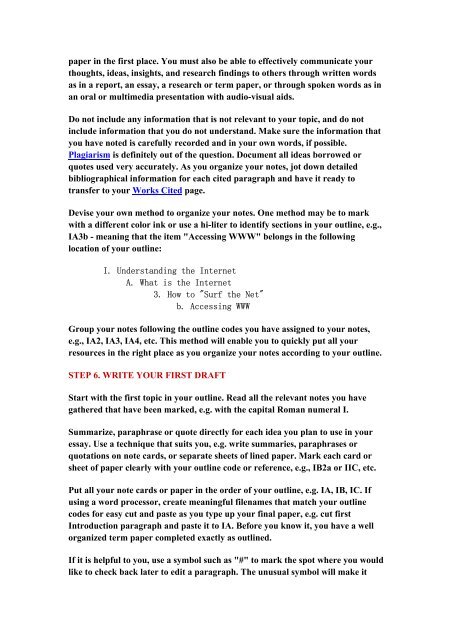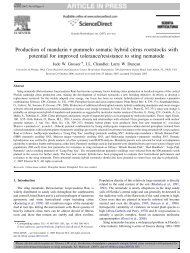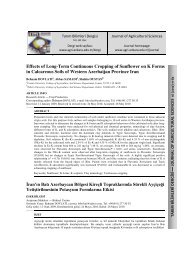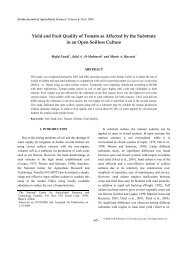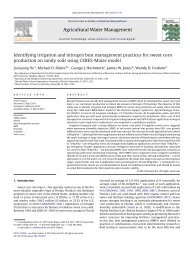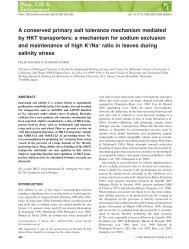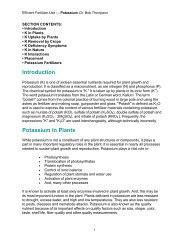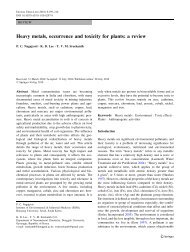Chapter 1. How to Write an A+ Research Paper
Chapter 1. How to Write an A+ Research Paper
Chapter 1. How to Write an A+ Research Paper
Create successful ePaper yourself
Turn your PDF publications into a flip-book with our unique Google optimized e-Paper software.
paper in the first place. You must also be able <strong>to</strong> effectively communicate yourthoughts, ideas, insights, <strong>an</strong>d research findings <strong>to</strong> others through written wordsas in a report, <strong>an</strong> essay, a research or term paper, or through spoken words as in<strong>an</strong> oral or multimedia presentation with audio-visual aids.Do not include <strong>an</strong>y information that is not relev<strong>an</strong>t <strong>to</strong> your <strong>to</strong>pic, <strong>an</strong>d do notinclude information that you do not underst<strong>an</strong>d. Make sure the information thatyou have noted is carefully recorded <strong>an</strong>d in your own words, if possible.Plagiarism is definitely out of the question. Document all ideas borrowed orquotes used very accurately. As you org<strong>an</strong>ize your notes, jot down detailedbibliographical information for each cited paragraph <strong>an</strong>d have it ready <strong>to</strong>tr<strong>an</strong>sfer <strong>to</strong> your Works Cited page.Devise your own method <strong>to</strong> org<strong>an</strong>ize your notes. One method may be <strong>to</strong> markwith a different color ink or use a hi-liter <strong>to</strong> identify sections in your outline, e.g.,IA3b - me<strong>an</strong>ing that the item "Accessing WWW" belongs in the followinglocation of your outline:I. Underst<strong>an</strong>ding the InternetA. What is the Internet3. <strong>How</strong> <strong>to</strong> "Surf the Net"b. Accessing WWWGroup your notes following the outline codes you have assigned <strong>to</strong> your notes,e.g., IA2, IA3, IA4, etc. This method will enable you <strong>to</strong> quickly put all yourresources in the right place as you org<strong>an</strong>ize your notes according <strong>to</strong> your outline.STEP 6. WRITE YOUR FIRST DRAFTStart with the first <strong>to</strong>pic in your outline. Read all the relev<strong>an</strong>t notes you havegathered that have been marked, e.g. with the capital Rom<strong>an</strong> numeral I.Summarize, paraphrase or quote directly for each idea you pl<strong>an</strong> <strong>to</strong> use in youressay. Use a technique that suits you, e.g. write summaries, paraphrases orquotations on note cards, or separate sheets of lined paper. Mark each card orsheet of paper clearly with your outline code or reference, e.g., IB2a or IIC, etc.Put all your note cards or paper in the order of your outline, e.g. IA, IB, IC. Ifusing a word processor, create me<strong>an</strong>ingful filenames that match your outlinecodes for easy cut <strong>an</strong>d paste as you type up your final paper, e.g. cut firstIntroduction paragraph <strong>an</strong>d paste it <strong>to</strong> IA. Before you know it, you have a wellorg<strong>an</strong>ized term paper completed exactly as outlined.If it is helpful <strong>to</strong> you, use a symbol such as "#" <strong>to</strong> mark the spot where you wouldlike <strong>to</strong> check back later <strong>to</strong> edit a paragraph. The unusual symbol will make it


